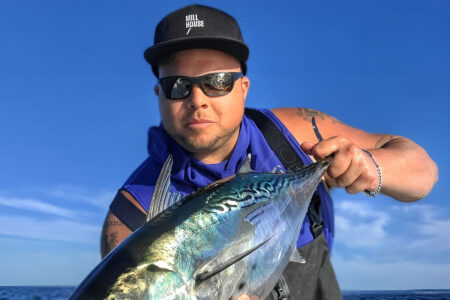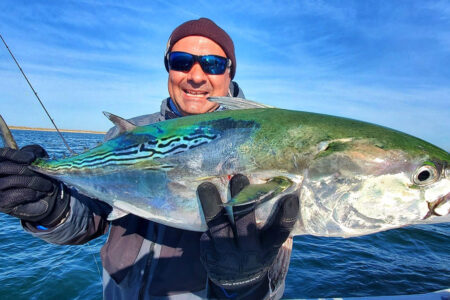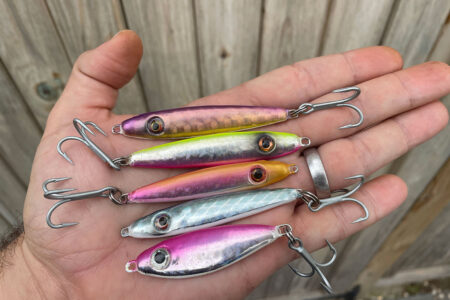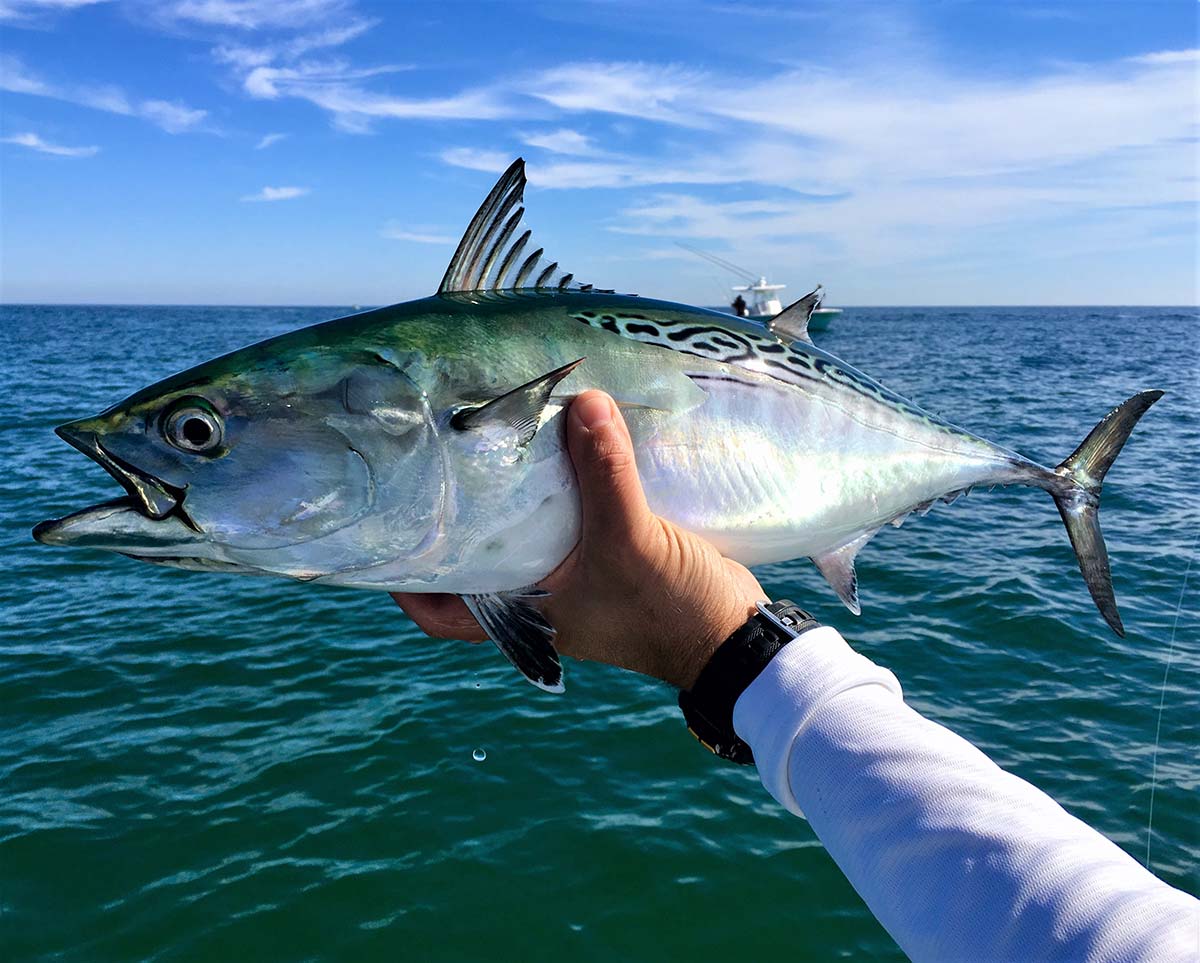
Over the last half-dozen years or so, the peak of the run in the Sound has occurred towards the end of September and into October.
During the late 1990s, false albacore began to make their first sustained appearances in the waters of the Long Island Sound. At that time, many anglers mistakenly thought that these small inshore pelagics were just finicky bluefish. All one had to do was listen to the chatter on marine band radios to confirm their presence: “What are these “bleeping” things? We can’t hook up.” Although times have indeed changed with new techniques and artificial baits, and catch rates are high, there are still some anglers who find hooking and landing albies to be a frustrating game. But a mantra that I adopted along the way is that ‘albies ain’t so tough.’
My journey with false albacore actually began in the mid-1970s when Atlantic bonito were often as prolific in the Sound as were bluefish. Learning to catch those migratory speedsters gave me many insights into catching their football-shaped cousins that now infiltrate the Sound. The behaviors and migration patterns of bonito, in many ways, parallel those of little tunny. While the numbers of bonito now visiting the Sound have diminished, false albacore populations have flourished. Although numbers may vary year to year, there have been times when the visiting population of albies in the Sound has rivaled the fabled Montauk runs. After catching countless false albacore over the years on both light tackle and fly gear, the following experiences might shed some light on your own fishing quest for these eagerly awaited and worthy opponents.
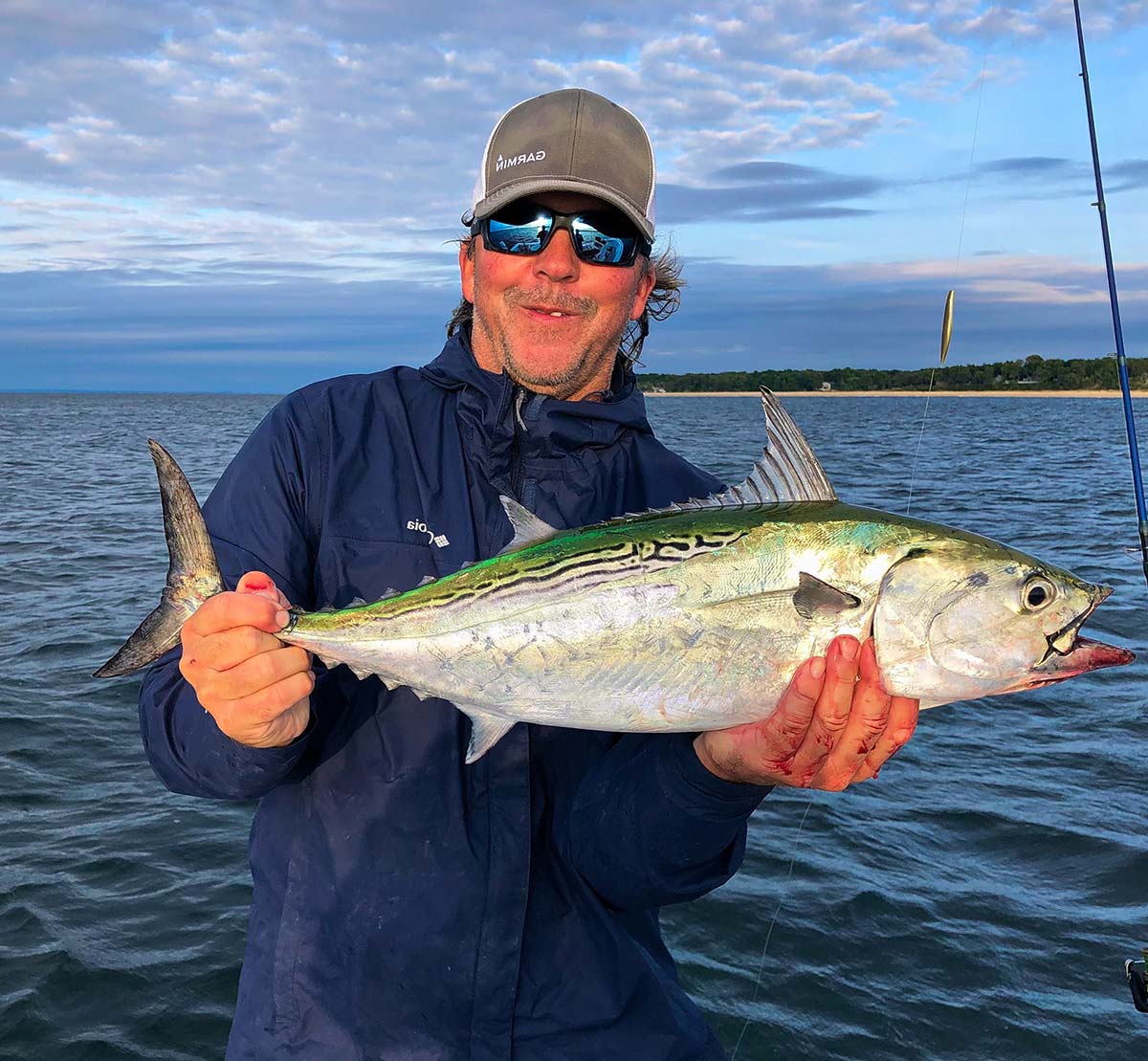
Late Summer Arrival
Albies make relatively predictable appearances in the Sound during late August and build in intensity and mass as the fall advances. Over the last half-dozen years or so, the peak of the run in the Sound has occurred towards the end of September and into October. Much of that has to do with the effects of climate change on water temperatures and the movement of bait.
In some years, anglers might still find pockets of albies around well into November. During the initial phases of the run, a few concentrated pods will enter the Sound, and those early fish are often very “hot” and responsive to artificial baits. Those few pods can quickly develop into many fish dispersed throughout the Sound. One of the critical elements for a continuing albie run is the presence of solid bait concentrations. Fat Albert’s will readily consume silversides, spearing, bay anchovies, peanut bunker, and small snappers. Some of the best runs of albies track with the presence of large masses of rain bait like bay anchovies. Schooling albies will consistently frequent harbors, inlets, rock promontories, shoals, tidal pond outflows, and offshore areas. It is quite the sight to see false albacore herd bay anchovies into tight quarters in quiet backwaters and then systematically assault them. Any configuration of structure that causes currents and tide to move in such a way as to tumble bait about is a potential area of opportunity.
A friend and I once caught albies in such skinny water that it felt like catching bonefish on a tropical sand flat. The Long Island Sound false albacore run builds to a crescendo in mid-fall with fish spread out from western Sound out to the areas surrounding Orient Point. The East End of the North Fork is where numbers of fish can often be measured in terms of acres; late September and October are the two best months for the hottest albie action. False albacore are reasonably tolerant of changes in water temperature and will often remain in the waters of the Long Island Sound through the middle of the fall. In exceptional years, they have been caught into the early days of November. Find the bait and locate suitable water temperatures, and chances are good for enjoying an extended hardtail season long after others have given them up for their voyage south.
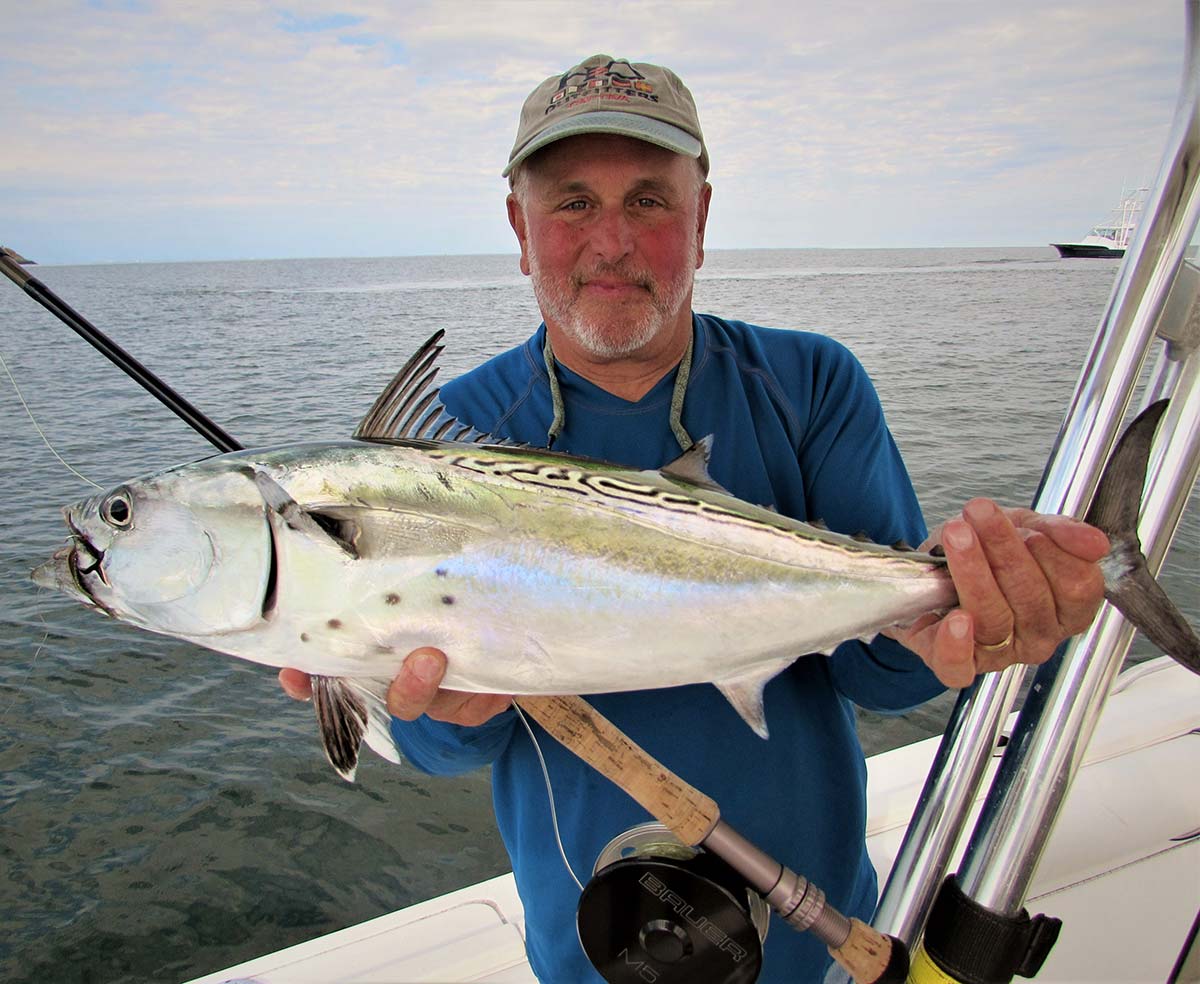
A Football’s Profile
Albies are members of the same family of fish as mackerel and tuna. They are hydrodynamic speedsters built somewhat along the template of larger, stouter true tuna. A unique identifying characteristic of little tunny is a series of dark spots that look somewhat like fingerprints between the pectoral and ventral fins. Another telltale feature is the wavy and worm-like, vermiculated markings located on the backs of albies, somewhat behind the shoulder area. The general coloration of albies is an iridescent blue-green hue with a dark back and a mottled white to the silvery lower flank region and belly. Like other tunas and mackerel, albies, light up when first caught with an almost neon-sign quality. Most Long Island Sound albies run up to about eight pounds, but they do reach sizes in our area up to 12 and 15 pounds. A previous NYS record false albacore of 16 plus pounds was caught in the eastern Sound.
Albies typically follow their close cousins, Atlantic bonito, and Spanish mackerel inshore. Much like bluefish, the surface feeding activity of albies attracts the attention of terns and gulls — and an armada of light-tackle boats. This feeding pattern is often mistakenly thought to be the work of choppers. One of the differences of this topside feeding behavior is that bluefish will slash and splash, while albies attack with surgeon’s precision and lightning speed, often leaping and proposing from the water as they herd and corral bait. Hard tails will dash from point to point with incredible velocity; here one minute, gone the next! Fewer terns will often be on the fast-moving and leaping pods of littler tunny, unlike the extensive mayhem that takes place over huge schools of bluefish. I have often been clued to the whereabouts of an actively feeding albie pod just by the presence of a single following and diving tern.
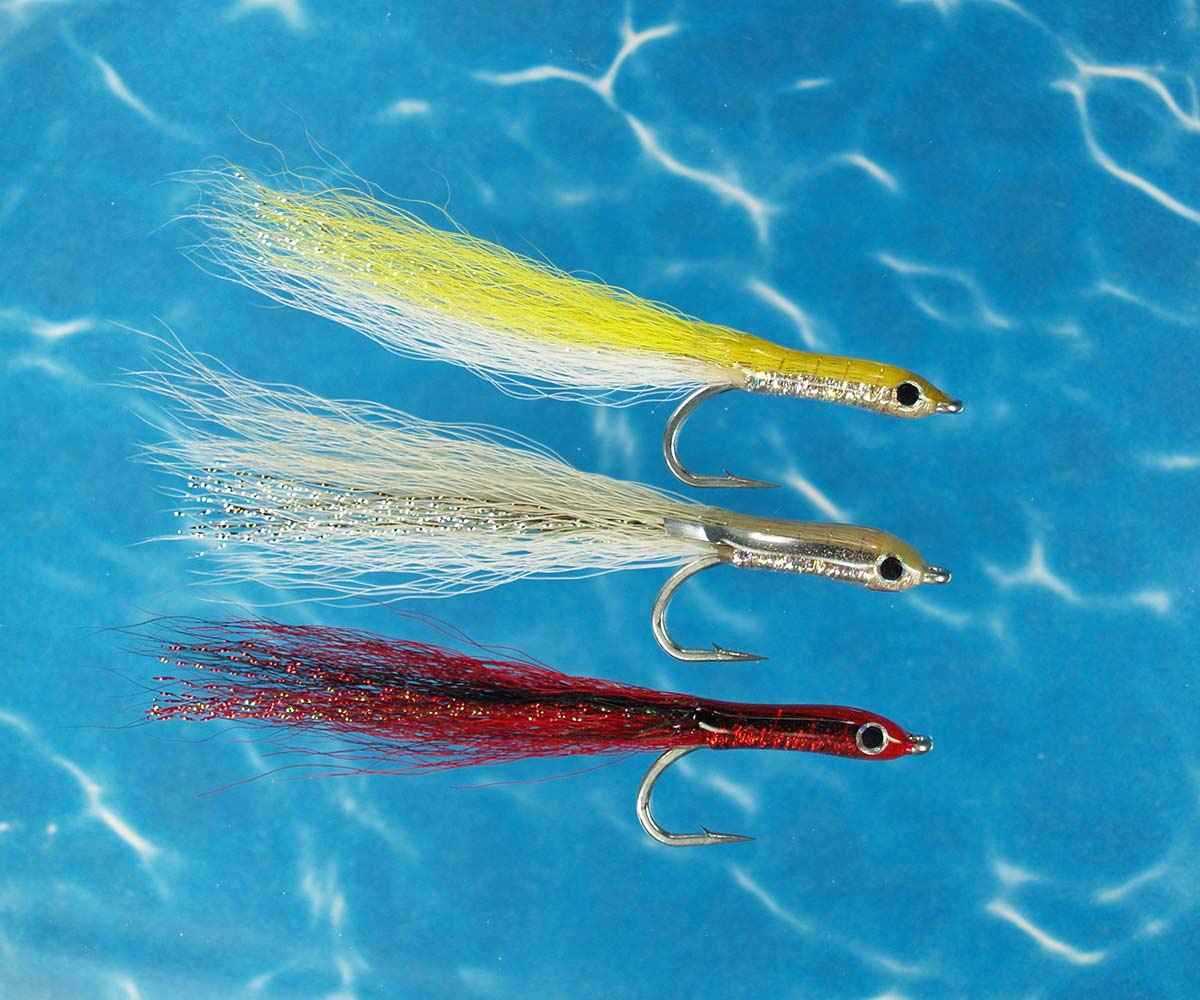
Angling Methods
The arrival of no other sport fish causes as much crazed chaos among the light tackle and fly-fishing community as does the appearance of migrating “tunny .” Anglers wait all season for this fish to finally show its fins. Albies can be finicky feeders or voracious gluttons. They can either totally ignore your best offering or hit with reckless abandon anything thrown their way. While they may seem difficult to hook at times, albies will readily take flies, small tins, plugs, and plastics.
False albacore are schooling fish, so find one, and there will be plenty more around, usually in the form of small pods that work in concert to corral and push bait to the surface, a trait beneficial to light tackle and fly anglers. The standard fishing methodology for albies involves mostly visual observations of feeding fish. Their tendency to leap from the water after prey is frequently the giveaway to their presence. Diving birds following pods of albies are another indicator of activity. You will often observe terns or gulls behaving somewhat differently than they do when atop schools of feeding bluefish or stripers. In those cases, the birds appear to almost linger for a bit as they hover above the feeding fish while picking off the hapless bait. When following little tunny, the movement of birds is much more frenetic as they keep pace with the fast-moving fish. The pure speed of the albies is what presents a real challenge to the angler. Flipping a fly or lure into the melee takes speed of cast, accuracy, and some modicum of discipline, especially with the fly rod.
The traditional casting approach when fishing from a boat is to get into the feeding zone and wait for albies to bust bait on the surface. The angler should attempt to determine, as best as possible, the feeding direction of the pod and try to intercept that path — much easier said than done. When the fish surface, make a quick, accurate cast ahead of the group and in a manner that will have the fly or lure pass in front of the feeding fish. Retrieves can vary, but one of the more popular methods with a fly rod is the double overhand retrieve, stripping line with one hand and then the other at a rapid pace. When a fish takes, a combination strip set and rod lift work well in tandem to drive the hook home. Slow, long, single-handed pulls also can be effective. A stripping basket comes in handy when retrieving in this fashion and aids immensely with line control. I’ve found that getting the fly or other artificial into motion quickly can often be the key to hook-up success when targeting surface-feeding hardtails. Once in an area frequented by fish, blind-casting can also yield results.
Lighter-sized gear is not only more efficient for catching the fish but, if matched properly to the size of the quarry can also minimize the fight and reduce the stress on those fish that are to be released. Lines of 10 to 12-pound test diameters enable a small lure to get into the zone quickly and allow the angler to cast lighter artificials much farther than heavier and thicker lines. This is also helpful when fast casts are made into the wind. With spinning gear, this one element of smaller line diameter has been the key to the consistency of hook-ups. With a fly rod, my preferred line is a 15-foot sink tip. I have had much more success with this line than either floating or lesser-density intermediate sink tips. While you can certainly subdue albies with an eight-weight rod, 9-foot nine or 10-weight is preferred.
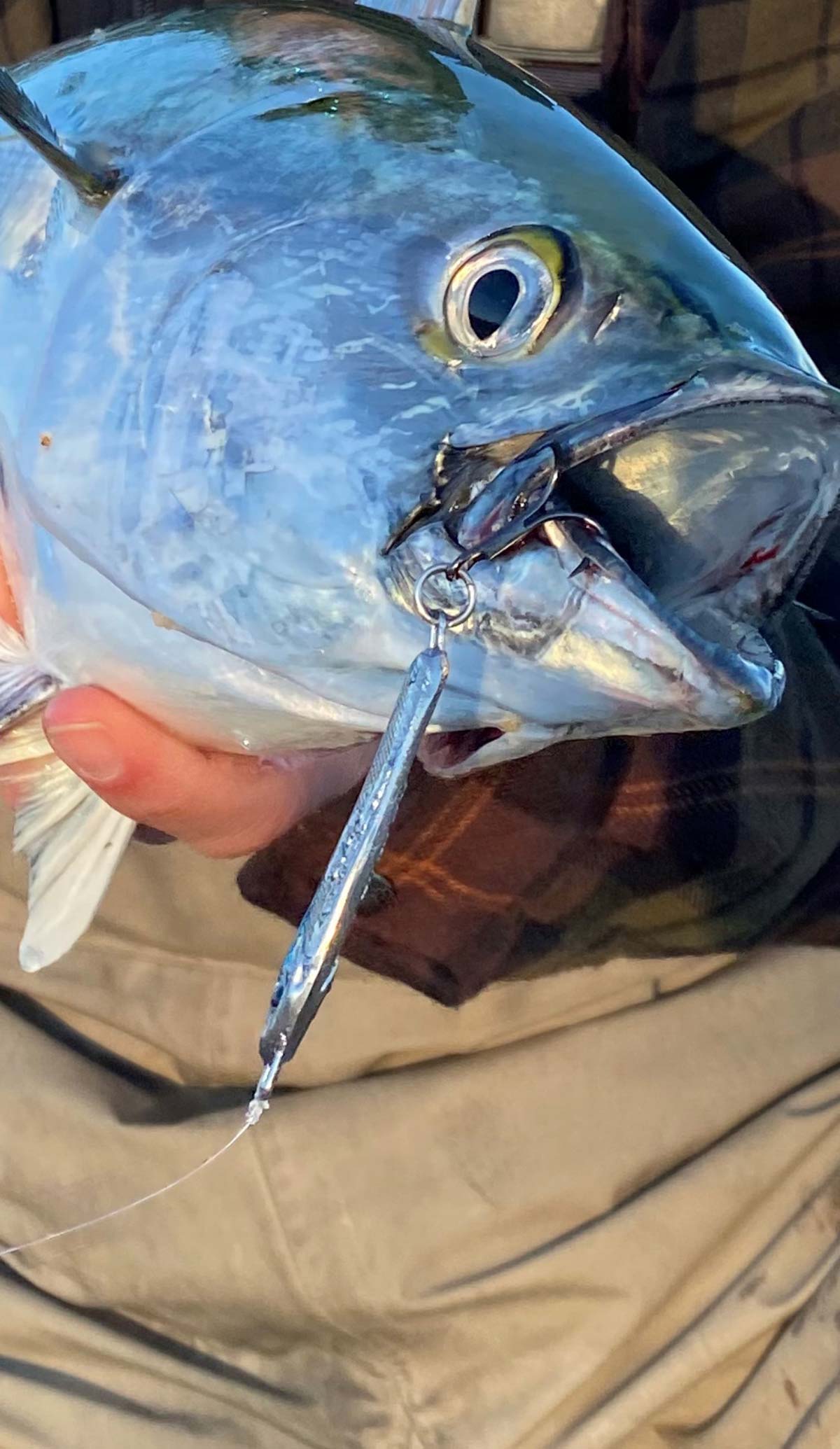
A Few Special Tactics
False albacore will readily take the easy pickings from the table. Once a pod of fish slashes through baitfish, they will often remain in the area to pick off remnants of the carnage. I’ve watched injured spearing flutter slowly down the water column, only to be snatched from their free fall by a supercharged albie materializing from the depths. Albies will hang around to capitalize on these easy meals, and as such, “do-nothing” retrieves also work well.
After the initial casting to breaking fish, allow the fly or lure to simply descend with minimal retrieving action. Every once in a while during the descent, move the line ever so slowly, as if the fly or lure were an injured or stunned baitfish attempting to regain its stability. When employing this technique with a fly rod, it pays to have a fly that will display flash while flickering down. I make it a point to keep a rod rigged with a sinking tip or sinking line at the ready for just these situations. The same technique works well with small tins and even swimming plugs; let tins flutter, and stop and start a retrieve with plugs.
Albies can also be caught from the beach, from jetties, and other locations where they are able to push and pin baitfish. Catching them by wading an open beach is a tough proposition since they move about so quickly, yet it can be done with a reasonable degree of regularity. The best approach for this type of fishing is to select an area albies are known to frequent and just hang loose until they show. This game takes patience and a bit of good fortune. Try to position yourself in such a way as to be close to areas where the fish corral the bait. When I first started fishing for albies that is precisely what I did. I’d hang in the area so long that other boaters would come over to check on me and see if all was okay. They’d leave, the albies would show, and all was good with the world. For some, fishing for albies adds new meaning to the term run and gun — a process of chasing down pods of surface-feeding fish.
Go Small, Go Large
Albies have a fondness for smaller bait and, therefore, smaller flies. I have caught them on the smallest of saltwater flies, but I have also seen them caught on the largest plugs. Two of their favored baitfish are bay anchovies and small spearing. There are times when albies get extremely selective, particularly when they are zoned in on diminutive baits. That is usually when the fishing is most frustrating, and the angler has to match size, color, and profile exactly. Yet, there are also times when they will feed indiscriminately on larger bait and eat whatever fly or lure you toss at them. One of the biggest challenges an angler faces when casting to fall run albies feasting on masses of anchovies is getting the artificial noticed. Therefore, it is sometimes effective to go against the flow of bait and show the fish something that stands out from among the pack of bait — a distinctly different profile and form. For me, this means somewhat bigger and flashier artificials — attention grabbers.
| RUNNING AND GUNNING |
| Since albies move about quickly this can become a very intense and frenzied affair. Many boating anglers will often motor about, running from one pod to the next. In areas where there are numerous fish and lots of boats this scene is as close to controlled pandemonium as one can get. Some might suggest that it is totally out of control; while lines may cross and tempers flare, fish do get caught. Have patience and take it slow. |
Some of the more popular flies in use on Long Island for albies are: Small to medium Deceivers, medium to large Clouser Deep Minnows, Epoxy Baitfish patterns, Bonito Bunny, Foxy Bone, and Glass Minnows. Patterns and lures that replicate bay anchovies (rain bait), spearing, peanut bunker, and sand eels are especially effective. As for small tins, you can sample the following: Epoxy jigs, Krocodile Spoons, Crippled Herring, Deadly Dick, Kastmaster, an old favorite- the Sidewinder, small Hopkins, small diamond jigs, and Yo-Zuri Minnow Jigs. Soft baits like Sluggos, Hogys, and Albie Snax are also very effective. And don’t forget to give small swimming and top-water plugs a try as well, like Yo-Zuri’s Edge Minnow. Be creative; you will be amazed at what frenzied albies will hit.

